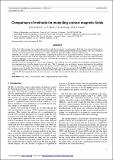Comparison of methods for modelling coronal magnetic fields
Abstract
Aims. Four different approximate approaches used to model the stressing of coronal magnetic fields due to an imposed photospheric motion are compared with each other and the results from a full time-dependent magnetohydrodynamic (MHD) code. The assumptions used for each of the approximate methods are tested by considering large photospheric footpoint displacements. Methods. We consider a simple model problem, comparing the full nonlinear magnetohydrodynamic evolution, determined with the Lare2D numerical code, with four approximate approaches. Two of these,magneto-frictional relaxation and a quasi-1D Grad-Shafranov approach, assume sequences of equilibria, whilst the other two methods, a second-order linearisation of the MHD equations and Reduced MHD, are time-dependent. Results. The relaxation method is very accurate compared to full MHD for force-free equilibria for all footpoint displacements but has significant errors when the plasma β0 is of order unity. The 1D approach gives an extremely accurate description of the equilibria away from the photospheric boundary layers, and agrees well with Lare2D for all parameter values tested. The linearised MHD equations correctly predict the existence of photospheric boundary layers that are present in the full MHD results. As soon as the footpoint displacement becomes a significant fraction of the loop length, the RMHD method fails to model the sequences of equilibria correctly. The full numerical solution is interesting in its own right, and care must be taken for low β0 plasmas if the viscosity is too high.
Citation
Goldstraw , E E , Hood , A W , Browning , P K & Cargill , P J 2018 , ' Comparison of methods for modelling coronal magnetic fields ' , Astronomy & Astrophysics , vol. 610 , A48 . https://doi.org/10.1051/0004-6361/201731069
Publication
Astronomy & Astrophysics
Status
Peer reviewed
ISSN
0004-6361Type
Journal article
Description
Funding: STFC through the Consolidated grant ST/N000609/1 (AWH); STFC studentship, ST/I505999/1 (EEG).Collections
Items in the St Andrews Research Repository are protected by copyright, with all rights reserved, unless otherwise indicated.

